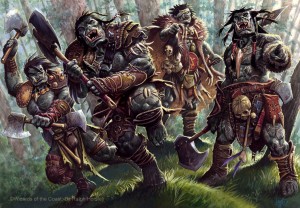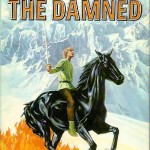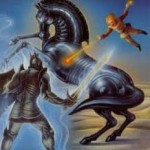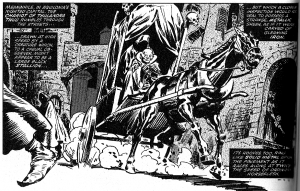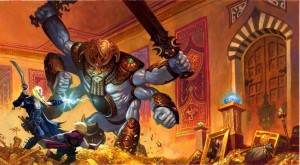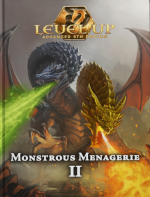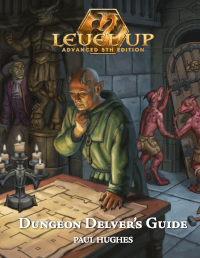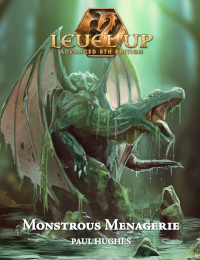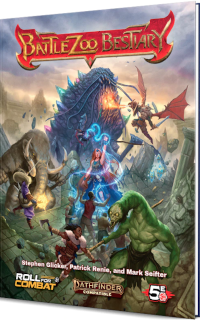 The 4e removal of the 3e “Craft” and “Profession” skills didn’t really make much of a difference to me, for the most part. As the 4e people say, “If you want to be a baker, just write ‘baker’ on your character sheet.” Baking doesn’t come up much in my campaign, more’s the pity. Sailing, might, and I kind of miss having a skill for it.
The 4e removal of the 3e “Craft” and “Profession” skills didn’t really make much of a difference to me, for the most part. As the 4e people say, “If you want to be a baker, just write ‘baker’ on your character sheet.” Baking doesn’t come up much in my campaign, more’s the pity. Sailing, might, and I kind of miss having a skill for it.
How do you handle sailing checks? Do you use balance checks for running the rigging? Nature checks for spotting storms? I couldn’t even decide what attribute is the key one for sailing a ship. You could make an argument for several: Dexterity for climbing the rigging, Intelligence for doing navigational calculations, etc.
Thinking about that, it seems logical to make sailing be a whole-party skill challenge. However, since there aren’t really enough appropriate skills, maybe they should just be ability checks.
Here’s how you might handle a storm at sea:
“A sail breaks loose. Someone strong needs to haul on the rope before a mast breaks.” The fighter makes a Strength check to haul on the rope.
“A wave hits the ship’s quarter, sending the wheel spinning and breaking the helmsman’s arm. Someone with a high Constitution needs to grab the wheel and hold it straight, no matter how much abuse they take from the wind, rain, and bucking of the wheel. Not the fighter, he is still hauling on the rope.” The sorcerer, who has a decent constitution, grabs the wheel.
“Someone with a good Wisdom should climb up in the crow’s nest and watch the wind direction.” Cleric climbs into the crow’s nest. Etc.
If the party succeeds on half or more of their checks, they succeed at the challenge.
What should be the DC of these checks? Straight ability checks have much less variation than skill checks; and the few abilities and items that boost ability checks are often suboptimal choices and might as well be rewarded anyway. You can expect that if all the players are heroic level, using their best or second-best ability, they will have +3, +4, or +5 bonuses, plus half level. If the DC is 15 plus half level, allowing players to succeed on a d20 roll of 11 or better, a party of 3 or 5 characters would have about a 50% chance of success, and a party of 4 characters a 70% chance of success. If the DC is 10, an odd number of PCs have a 90% chance of success, and an even number has 95%. We’ll say, therefore, that DC 10+1/2 level is easy and DC 15+1/2 level is hard.
At epic levels, player abilities are higher: top ability bonuses average +7 instead of +4. Therefore, you can safely pitch more DC 15+1/2 level challenges at players, or, on the other hand, just let the PCs succeed more. One of the benefits of being high level is that you are good at everything, and that might translate into more sailing successes.
How is the re-usability of this skill challenge? If the PCs have a ship, they may face sailing challenges often. When a sailing check is needed, each PC can have an accustomed role. Everyone makes their check and the successes are tallied. There’s one or two roles per ability:
STR oarsman (or rope hauler, if needed)
CON helmsman (or pumper, if the skip is sinking)
DEX topman (rigging) (or weaponmaster, in ship-to-ship combat)
INT navigator (or sailmaster, to get maximum speed)
WIS lookout (or pilot, in dangerous waters)
CHA captain or mate (or leader of the boarding party, in shipboard combat)
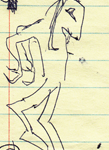 Bunnies are not predatory animals, though, so I don’t see bunny wights having the same hunger for human blood possessed by most undead. Rabbits are sort of tragic animals – the bottom of the food chain. Bunny wights come out of the water sad, leaden-footed, at the command of the creatures who once preyed on them. They walk in from the surf, one or two at first, with more behind, until an army of them is trudging on the shore, heads bowed, slimy ears dangling behind them like seaweed.
Bunnies are not predatory animals, though, so I don’t see bunny wights having the same hunger for human blood possessed by most undead. Rabbits are sort of tragic animals – the bottom of the food chain. Bunny wights come out of the water sad, leaden-footed, at the command of the creatures who once preyed on them. They walk in from the surf, one or two at first, with more behind, until an army of them is trudging on the shore, heads bowed, slimy ears dangling behind them like seaweed.
